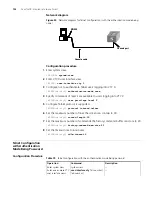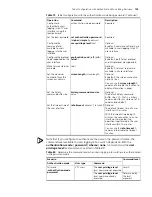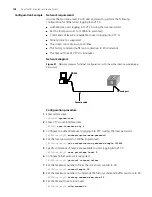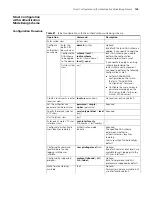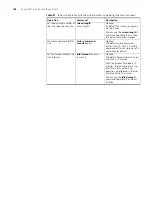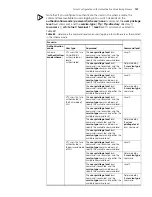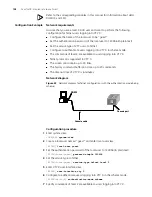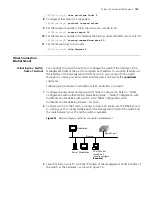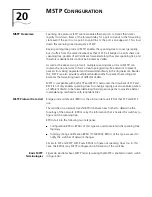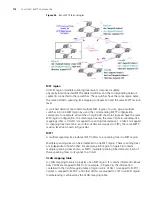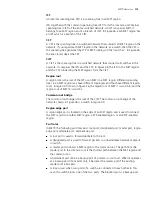
100
C
HAPTER
19: L
OGGING
IN
THROUGH
T
ELNET
Telnet Configuration
with Authentication
Mode Being None
Configuration Procedure
Scheme
Specify to
perform local
authentication or
RADIUS
authentication
AAA configuration
specifies whether to
perform local
authentication or
RADIUS authentication
Optional
Local authentication is
performed by default.
Refer to “AAA&RADIUS
Configuration” for more.
Configure user
name and
password
Configure user names
and passwords for
local/remote users
Required
■
The user name and
password of a local user are
configured on the switch.
■
The user name and
password of a remote user
are configured on the
RADIUS server. Refer to user
manual of RADIUS server for
more.
Manage VTY
users
Set service type for
VTY users
Required
Perform common
configuration
Perform common
Telnet configuration
Optional
Refer to Table 75.
Table 76
Telnet configurations for different authentication modes (Continued)
Authentication
mode
Telnet configuration
Description
Table 77
Telnet configuration with the authentication mode being none
Operation
Command
Description
Enter system view
system-view
—
Enter one or more VTY
user interface views
user-interface vty
first
-
number
[
last-number ]
—
Configure not to
authenticate users
logging into VTY user
interfaces
authentication-mode none
Required
By default, VTY users are
authenticated after logging in.
Configure the
command level
available to users
logging into VTY user
interface
user privilege level
level
Optional
By default, commands of level 0 are
available to users logging into VTY
user interfaces.
Configure the
protocols to be
supported by the VTY
user interface
protocol inbound
{
all
|
ssh
|
telnet
}
Optional
By default, both Telnet protocol and
SSH protocol are supported.
Make terminal services
available
shell
Optional
By default, terminal services are
available in all user interfaces.
Set the maximum
number of lines the
screen can contain
screen-length
screen-length
Optional
By default, the screen can contain
up to 24 lines.
You can use the
screen-length
0
command to disable the function to
display information in pages.
Summary of Contents for 4200G 12-Port
Page 10: ...8 CONTENTS...
Page 14: ...4 ABOUT THIS GUIDE...
Page 46: ...32 CHAPTER 5 LOGGING IN THROUGH WEB BASED NETWORK MANAGEMENT SYSTEM...
Page 48: ...34 CHAPTER 6 LOGGING IN THROUGH NMS...
Page 60: ...46 CHAPTER 9 VLAN CONFIGURATION...
Page 64: ...50 CHAPTER 10 MANAGEMENT VLAN CONFIGURATION...
Page 80: ...66 CHAPTER 13 GVRP CONFIGURATION...
Page 98: ...84 CHAPTER 15 LINK AGGREGATION CONFIGURATION...
Page 112: ...98 CHAPTER 18 MAC ADDRESS TABLE MANAGEMENT...
Page 126: ...112 CHAPTER 19 LOGGING IN THROUGH TELNET...
Page 162: ...148 CHAPTER 20 MSTP CONFIGURATION...
Page 274: ...260 CHAPTER 29 IGMP SNOOPING CONFIGURATION...
Page 276: ...262 CHAPTER 30 ROUTING PORT JOIN TO MULTICAST GROUP CONFIGURATION...
Page 298: ...284 CHAPTER 33 SNMP CONFIGURATION...
Page 304: ...290 CHAPTER 34 RMON CONFIGURATION...
Page 338: ...324 CHAPTER 36 SSH TERMINAL SERVICES...
Page 356: ...342 CHAPTER 38 FTP AND TFTP CONFIGURATION...
Page 365: ...Information Center Configuration Example 351 S4200G terminal logging...
Page 366: ...352 CHAPTER 39 INFORMATION CENTER...
Page 378: ...364 CHAPTER 40 BOOTROM AND HOST SOFTWARE LOADING...
Page 384: ...370 CHAPTER 41 Basic System Configuration and Debugging...
Page 388: ...374 CHAPTER 43 NETWORK CONNECTIVITY TEST...
Page 406: ...392 CHAPTER 45 CONFIGURATION OF NEWLY ADDED CLUSTER FUNCTIONS...

















